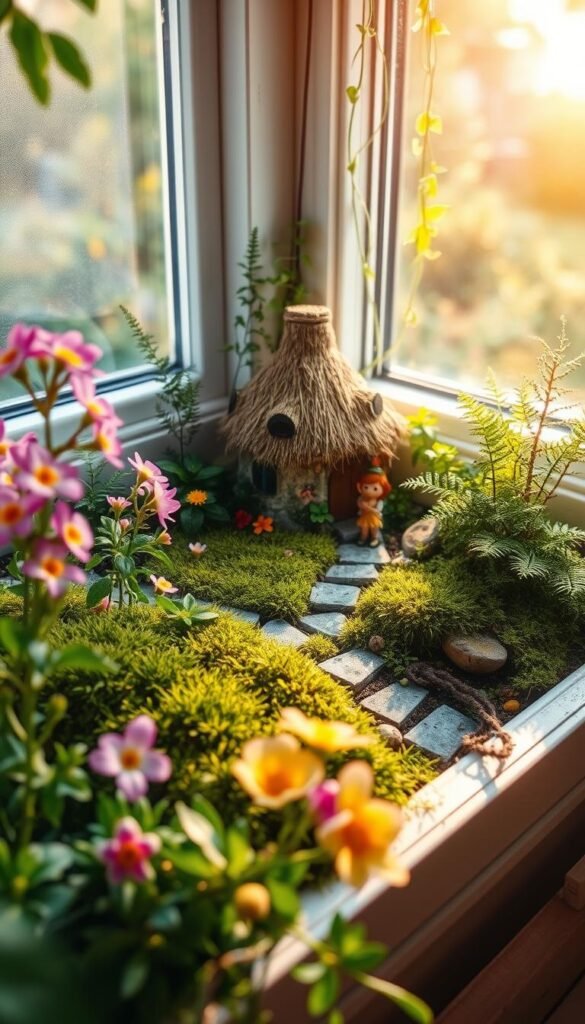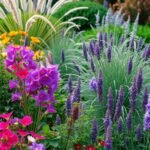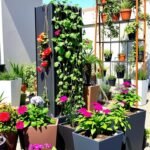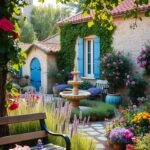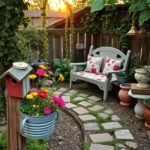What if you could shrink nature’s beauty into a palm-sized paradise? Tiny curated landscapes have blossomed from outdoor hobbies into imaginative home accents. These captivating displays blend creativity with natural elements, letting you design personalized ecosystems that spark daily wonder.
Originally popular in yards and patios, these artistic arrangements now thrive indoors where weather can’t disrupt their charm. A well-crafted display transforms ordinary containers into extraordinary realms using scaled-down flora and playful accents. Mini benches, winding pebble paths, and delicate cottages invite storytelling while connecting us to childhood imagination.
Beyond their visual appeal, these living artworks offer therapeutic benefits. Caring for petite plants like moss and succulents becomes a calming ritual. You’ll find endless ways to express personal style – from moonlit forest themes to sun-drenched meadow scenes. Best of all, they work year-round on tabletops, shelves, or windowsills.
Ready to craft your own slice of magic? This guide reveals how simple materials and everyday items can become portals to wonder. We’ll explore design principles, plant choices, and lighting techniques that make small spaces feel truly spellbinding.
Getting Started with Your Indoor Fairy Garden
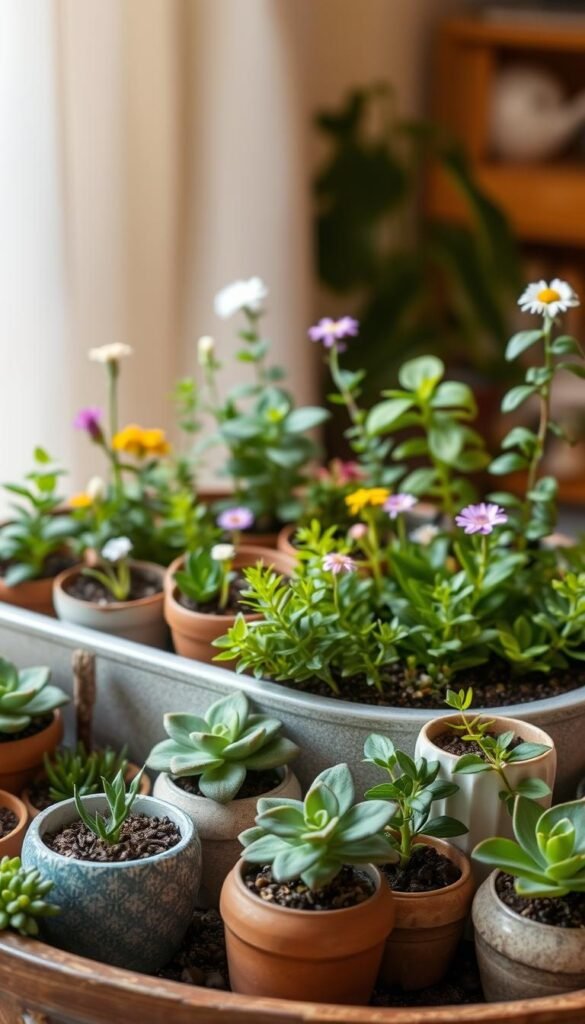
Your journey begins with three key decisions: where to place your creation, what to grow it in, and which tools you’ll need. Let’s turn ordinary items into extraordinary homes for your tiny greenery.
Choosing Your Perfect Container
Size matters more than you think. A 6-8 inch pot holds 2-3 small plants plus decorations. Always check drainage holes – no one wants soggy roots! No holes? Layer pebbles at the bottom.
| Container Type | Best For | Drainage Tip |
|---|---|---|
| Teacups | Single succulents | Add charcoal layer |
| Wooden Crates | Multi-plant scenes | Line with plastic |
| Glass Bowls | Moss gardens | Use aquarium gravel |
Essential Materials and Tools
Start with these garden supplies:
- Fast-draining soil (cactus mix works great)
- Miniature rake & trowel set
- Precision watering can
Place your creation where sunlight meets style. Kitchens and entryways offer perfect spots for daily enjoyment. For more colorful container gardening ideas, explore our seasonal planting guides.
Designing Your Miniature Fairy Ecosystem
Transform ordinary dirt into extraordinary wonderlands through smart scaling and thoughtful arrangement. Successful displays balance living greenery with artistic elements, creating depth that draws viewers into your tiny universe.
Planning Your Layout with Small Plants
Start with a centerpiece specimen like a juniper bonsai. Its twisted trunk becomes an instant fairy treehouse anchor. Surround it with air plants arranged like clustered shrubs – they thrive without soil, perfect for tight spaces.
Ground your scene with cushion moss between rocks. This living carpet stays vibrant with weekly misting. For height variety, add trailing sedum along container edges. Remember: roots need breathing room. Leave 1″ between specimens.
Setting the Scene with Whimsical Accents
Create pathways using:
- Crushed quartz for glittering trails
- Flat stones as stepping “boulders”
- Twig arches over pebble streams
Layer colored gravel under benches to suggest secret gathering spots. Match stone hues to your theme – rose quartz for dawn gardens, obsidian chips for midnight glades. These details make your creation feel inhabited, even when fairies are “away”.
Pro tip: Use tweezers to position tiny accessories without disturbing soil layers. Your patience will bloom into magical results!
Creative DIY Fairy Garden Accessories
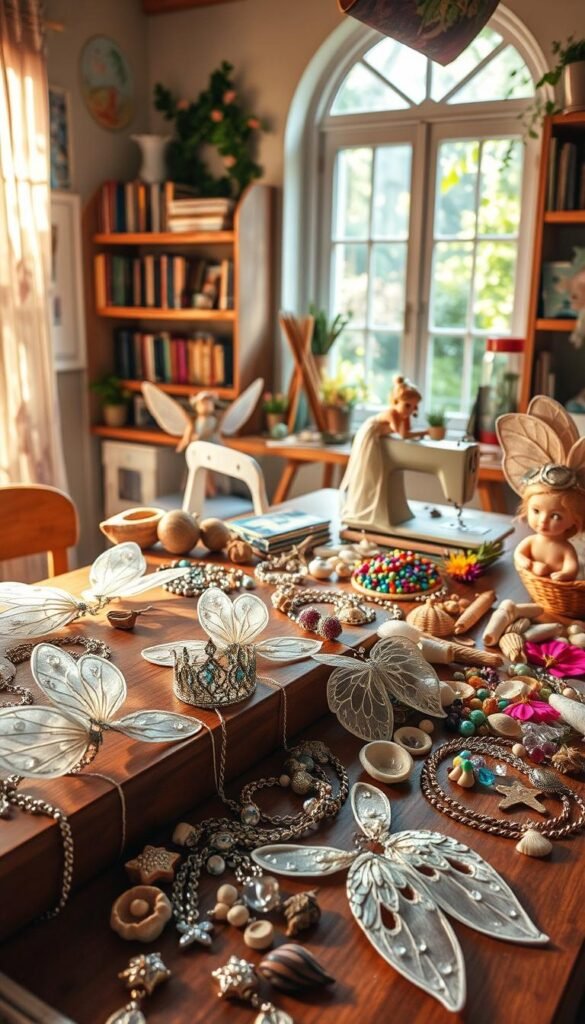
Transform ordinary craft supplies into magical elements that bring your tiny realm to life. With simple materials and clever techniques, you’ll design charming details that make your scene uniquely enchanting.
Crafting Fairy Houses and Mini Structures
Start with polymer clay – it’s perfect for shaping cottages with textured roofs. Roll thin sheets for shingles, and carve tiny doors using toothpicks. Bake your creation at 275°F for 15 minutes to harden. For rustic cabins, bundle popsicle sticks with twine and add mossy accents.
Build outdoor furniture using natural materials:
- Twig chairs with acorn cap seats
- Birch bark picnic tables
- Pinecone hanging swings
| Material | Best For | Pro Tip |
|---|---|---|
| Popsicle sticks | Doors & fences | Paint with milk paint for aged look |
| Polymer clay | Teacups & plates | Use silicone molds for consistency |
| Wire screening | Arches & gates | Spray-paint white for moonlight effect |
Create realistic weathering with dry-brush techniques. Dab gray paint on wood surfaces to mimic aged boards. For stone textures, layer brown and cream acrylics. Seal everything with matte varnish to protect against humidity.
Design themed sets using color stories. Try sage greens for forest workshops or pastels for tea parties. Add personality with tiny signs – write messages using micro-tip markers on birch slices. Your accessories will tell stories before visitors even lean in close!
Indoor Fairy Garden Ideas: Whimsical Miniature Worlds Anyone Can Create
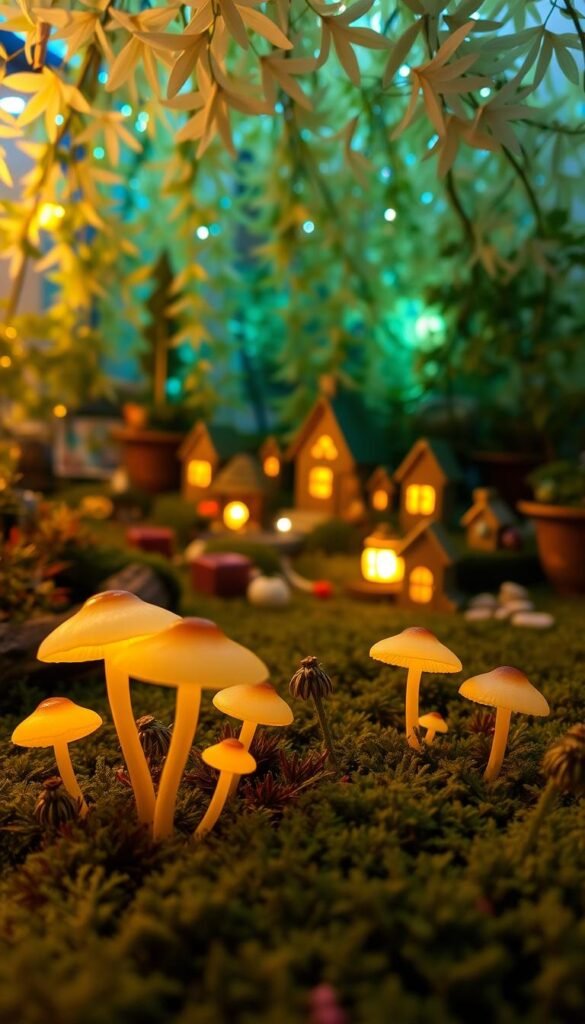
Light up your imagination with vessels that tell stories and illumination that casts spells. The right container becomes a stage for your tiny masterpiece, while strategic lighting breathes life into every leaf and pebble. Let’s explore creative garden ideas using everyday objects and modern tech to elevate your display from cute to captivating.
Selecting a Unique Receptacle
Think beyond basic pots for your miniature garden. That chipped teapot gathering dust? Drill drainage holes in its base for instant cottagecore charm. Try these eye-catching ideas:
- Mason jars: Double as planters and lanterns when wrapped with LED strips
- Vintage lunchboxes: Create multi-level scenes with removable trays
- Birdcages: Suspend air plants from the bars with nylon thread
Upcycle household items for personalized flair. An old typewriter opens to reveal succulent “keys,” while hollowed-out books make secret moss libraries. Always prioritize drainage or use sealed containers for faux landscapes.
Incorporating Magical Lighting Effects
Many miniature gardens shine brightest after dark using these illumination strategies:
- Twinkle lights woven through tiny trees like celestial vines
- BlissRadia orbs casting color-shifting glows behind rocky outcrops
- Projectors beaming starry skies onto nearby walls
Smart devices like the Sky Lite Evolve demonstrate this idea beautifully – switch between aurora borealis effects and meteor showers via app control. For seasonal fun, swap cool blue summer lights for warm amber autumn strands. Position lights low to create dramatic shadows that make miniature bridges look life-sized.
Pro tip: Bury micro-LEDs under translucent gravel to mimic glowing mushrooms. Your tiny paradise will wow viewers day and night!
Inspiration from Designers and Trendsetters
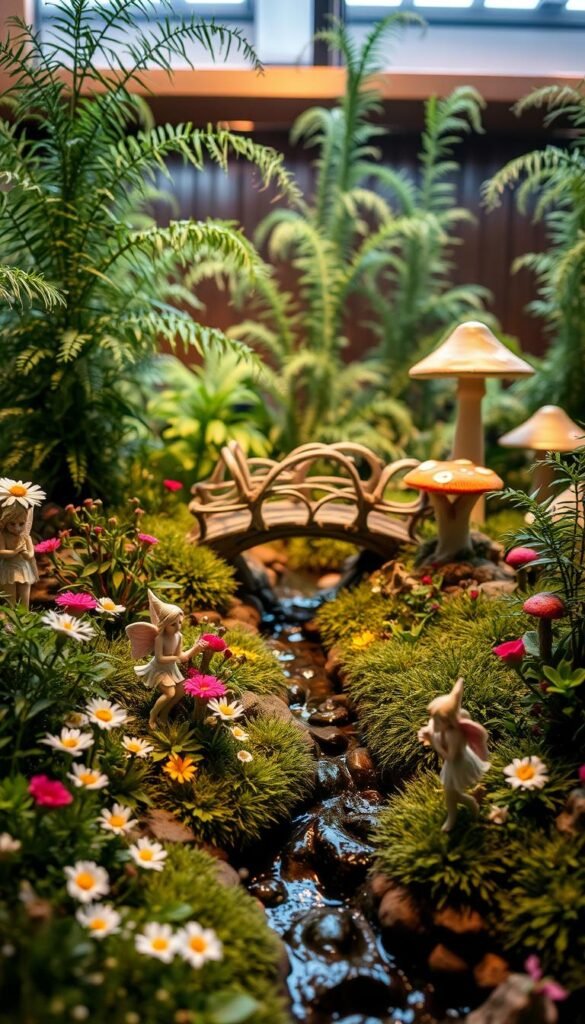
Ever wondered how pros turn trash into treasure for tiny landscapes? Top creators like Shirley Bovshow prove design magic happens when imagination meets resourcefulness. Their approaches reveal how strategic choices transform ordinary items into extraordinary scenes.
Expert Tips from Landscape Designers
Shirley Bovshow builds entire stories in containers using salvaged materials. “Every broken finial becomes a planter waiting to happen,” she explains. Her method layers plants with props that suggest hidden narratives – think weathered signs pointing to invisible villages.
Try these pro techniques:
- Use vertical space by stacking crates as multi-level scenes
- Bury container rims with moss to hide modern edges
- Position tallest elements first as visual anchors
Upcycling and Repurposing Everyday Items
Jean Neuweg hunts flea markets for dollhouse-sized treasures. A vintage thimble becomes a rain barrel. Scrap metal transforms into miniature gates. Her secret? “See objects smaller than their actual size,” she advises.
| Designer | Signature Technique | Sample Creation |
|---|---|---|
| Shirley | Architectural salvage | Lantern-to-greenhouse conversions |
| Jean | Found object repurposing | Button mosaic pathways |
Both experts emphasize scale relationships. A proper miniature garden feels lived-in when benches match plant heights. Test proportions by holding accessories near your plants before securing them. This simple trick prevents oversize mishaps!
Exploring Unique Container Options

Unlock hidden potential in everyday objects by reimagining them as homes for tiny greenery. From delicate porcelain to industrial castoffs, your display vessel becomes part of the storytelling magic. Let’s explore how common items evolve into extraordinary stages for nature’s smallest dramas.
Teacup, Mason Jar, and More
Turn dainty tableware into enchanting scenes. A floral teacup makes perfect sense for hosting imaginary tea parties – line its base with pebbles, add a succulent “cake,” and position mini chairs around a pebble table. Mason jars shine as self-contained ecosystems. Layer sand, soil, and moss inside, then hang tiny lanterns from the rim using fishing line.
| Container | Best Use | Pro Tip |
|---|---|---|
| Teacup | Single-scene displays | Use chalk paint to create “spilled tea” effects |
| Mason Jar | Humidity-loving plants | Rotate weekly for even growth |
| Bird Cage | Vertical arrangements | Attach air plants with floral wire |
Transformative Ideas with Unconventional Items
Vintage suitcases become portable wonderlands when lined with plastic and filled with drought-tolerant sedums. Their latches and handles add instant wanderlust charm. Old fish tanks offer crystal-clear views – try a desert theme with sand dunes and miniature cacti.
China cabinets transform into multi-level villages. Dedicate shelves to different biomes: a mossy forest floor below, mountain succulents above. Leave doors slightly ajar to prevent humidity buildup. Remember – drainage matters most. Drill holes in metal containers or use sealed pots inside decorative ones.
Bringing Your Indoor Fairy Garden to Life and Beyond
Now comes the moment when your tiny universe finds its heartbeat. Shape clay fairies with curled toes resting on pebbles, or position store-bought sprites peeking from behind mini garden houses. Each figure becomes a character in your living storybook – will they guard mossy thrones or tend to trailing vines?
Build depth through layered storytelling. A popsicle stick bridge spanning pebble rivers suggests journeys underway. Pressed flower garlands draped over twig arbors whisper of recent celebrations. Photograph these details at eye level to capture your scene’s personality, using natural light for authentic charm.
Keep your ecosystem thriving with weekly misting and seasonal rotations. Swap flowering plants in spring for berry sprigs during winter. Involve friends by hosting crafting nights – trade handmade accessories like acorn lanterns or walnut shell boats. Every addition becomes a shared memory rooted in creativity.
Your first creation sparks endless possibilities. Will your next fairy garden feature desert succulents in a reclaimed toolbox? Or perhaps a hanging terrarium with air plant chandeliers? The magic grows as you do – one tiny masterpiece at a time.

